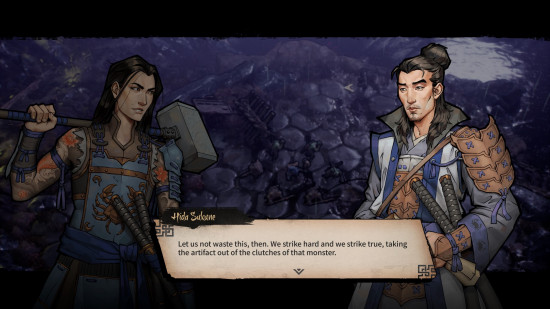Shadowveil: Legend of the Five Rings is an auto-battler-style roguelite with a tall order on its hands. Its release on March 4 marks the first time that the well-loved setting of Rokugan has been recreated in videogame form. Legend of the Five Rings is a well-loved franchise with a rich, deep history, plus a veteran fanbase filled with lovers of narrative and mechanical complexity. Capturing this in its entirety is an enormous task – and one that developer Palindrome Interactive has, perhaps wisely, chosen to avoid.
Legend of the Five Rings has taken many forms since its 1995 debut, most of them rich and deep. Its collectible card game was a crunchy, complex affair with multiple win conditions and a points-based system that allowed players to actually influence the storyline. Through the tabletop RPG and countless novels, the East-Asia-inspired fantasy setting of Rokugan grew more detailed and more alive.
You’d be forgiven for expecting a faction-heavy turn-based game in the same family as Total War: Warhammer, arguably the obvious focus of an IP like this. However, like the art of Japanese Haiku, Palindrome Interactive has opted for a sharper, more streamlined snippet of Rokugan.
Rather than exploring the setting’s many clans, Shadowveil focuses on just one – the brash and bold Crab Clan. A brief introduction explains that the Crab Clan is on the front lines of a battle against the corrupted Shadowlands and the demons and spirits that lurk within. The dialogue is clunky, but it’s clear enough to get me (who has never touched the tabletop RPG or card game) on board with the concept.
During my preview, game director Filip Andersson explained that Shadowveil was partly an attempt to invite more people into the world of Legend of the Five Rings. Shadowveil is still a strategy game at its core, but it’s one that’s “replayable and digestible”. At one point, Andersson claims it’s “something you can play during a lunch break”.
This is a pitch that’s watered down later on, as Andersson adds “I’m not sure this is a casual game, but it can be”. Perhaps the fear was of underselling the game’s strategic potential, which is understandable. Based on a first impression of the demo, the surprising depth of the mechanics seems like one of Shadowveil’s major strengths.
From the get-go, you’re given a choice of playstyle, taking control of the tactically-minded Sukune or the berserker O-ushi. Each run of the roguelite is a series of automated combat scenarios strung together, with all your tactical decisions made before or between fights.
You choose which class of units to deploy where, depending on what environmental benefits you want them to reap and which path you wish them to take toward the enemy. Cut down the goblins and ghouls that stand in your way, and your troops are rewarded – mainly with the precious resource of cards.
Cards offer new passive effects or cooldown-based abilities when applied to a particular unit. Some alter a specific class’ unique powers, while others offer more general buffs. The variety of classes, made further customizable by these cards, offers many paths to success, whether it be through careful area control, tank-y defense, or just going hard on your damage output.
The loop continues like this – plan and execute an automated encounter, heal and/or upgrade in your camp phase, and soldier on to more beefy enemy battles. As you progress through the Shadowlands, you can further customize the size and specialties of your army, although sometimes a tactical retreat is worth taking to gather your resources and fuel further upgrades at home base.
While most of your planning is done at a macro level, it’s possible to analyze the results on a micro level. Encounters can easily be paused for you to ponder combat logs (or sped up if things are a bit too simple). Hover over your enemies, and you can see the exact stats you’re up against.
I left my Shadowveil preview intrigued by the potential of the game but not overly blown away by the results I’d seen. However, this may be a limitation of the preview rather than the full game.
Andersson said that the game was a “journey”, intended to feel as alive as Rokugan’s previous iterations did. The world apparently evolves along with its mechanics, as recurring characters stop to taunt each other upon second meetings.
Supposedly, deeper in the Shadowlands, I’d find more and more strategic choices emerging from the smoke. I was promised boss fights and battlefields brimming with chaos, magic and spectacle.
All of these things sound wonderful, and the early game certainly seems to establish a foundation capable of supporting such complexity. But the version of Rokugan I saw was slow and static, still gearing up to be the addictive strategy experience I wanted.
For more brain-bending gaming, here are the strategy board games we’d recommend. Digital gamers may also enjoy trying some new WW2 games or Warhammer 40k games, all firmly within the strategy category.
Source: Wargamer




